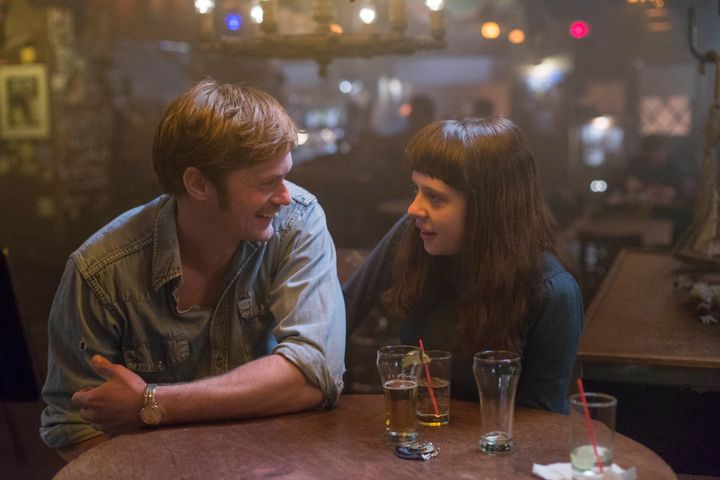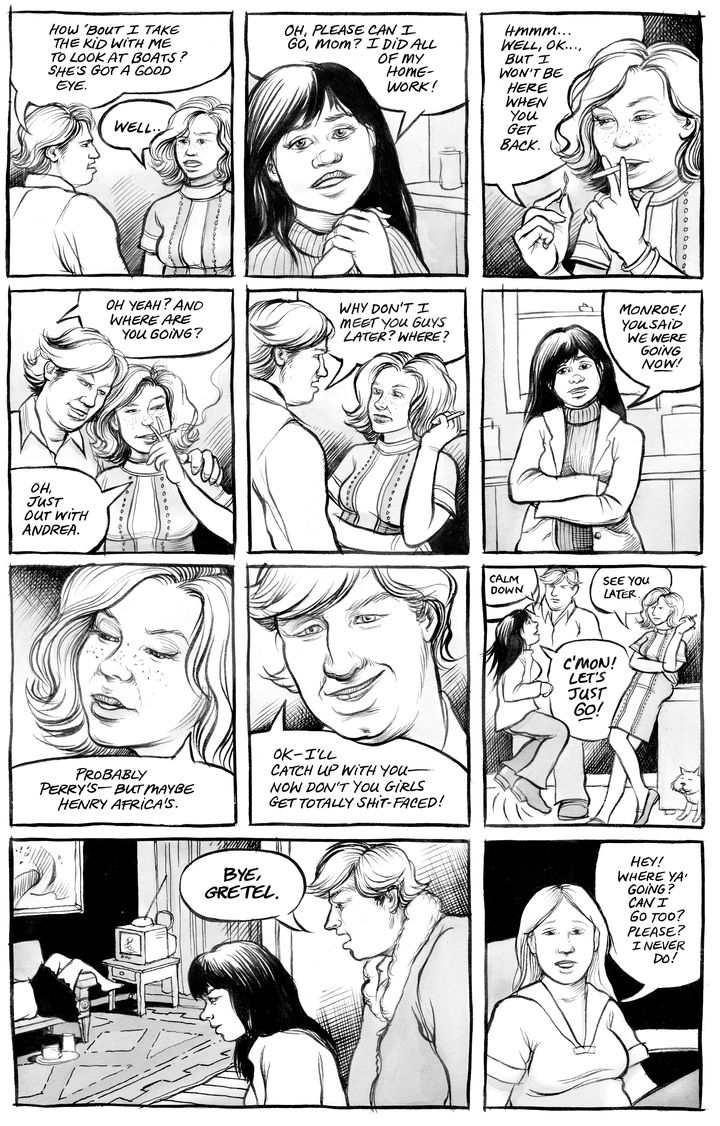
Teenagers are pretty pumped to have sex. It's the reason they go to parties, the subject of every locker room conversation and definitely the most important goal they have before reaching high school graduation. At least this is the case for the boys, right?
That's the prevailing narrative of most Hollywood films. Just queue up "Superbad," "American Pie" and "The 40-Year-Old Virgin" for proof. Dudes are obsessed with sex in movies and making that sex happen is typically plot point A.
But teenage girls are often left out of the narrative of sexual desire altogether -- and are instead put in the position of defense. They must decide when it’s time to give up their virginity, usually to the guy who has been persistent enough that she finally deems him worthy.
The leading character in the film “The Diary Of A Teenage Girl,” Minnie, tells us a different story -- and a truer one. She is really excited to have sex. Growing up in San Francisco in the 1970s, Minnie, 15, thinks about sex constantly. She talks about it with her friends, writes about it in her diary and thinks about it when attractive young men walk by.
When she loses her virginity and embarks upon an ongoing sexual relationship with her mother’s boyfriend, who is 20 years her senior, the story becomes much more complex. Seeing a film deal with young female sexuality head on is rare. Seeing a film about sex with a minor that is not about victimization is also rare.
Moviegoers are left with many questions when the screen fades to black in “The Diary Of A Teenage Girl.” Does it matter that Minnie pursued the much older Monroe? Can a 15-year-old make mature decisions about sex? Should Monroe be charged with statutory rape?
The Huffington Post spoke with filmmaker Marielle Heller, as well as the author of the autobiographical graphic novel, Phoebe Gloeckner, about how female sexuality is portrayed in the media and why women are getting the short end of the stick.
“As I grew older, my experience of feeing unrepresented in any medium grew stronger."”
“I was always curious about sex. My mother had Lolita and Naked Lunch. Anything with a title like that, I would read,” Gloeckner said. “I would get so angry when I read some of those things because I just felt like something was wrong -- and I couldn’t figure out what.”
Gloeckner kept a diary as a teen and used her writing and drawings (she’s also an illustrator) as source material for her graphic novel The Diary Of A Teenage Girl, which was published in 2003. It is a hybrid book featuring both prose and comics.
“I wrote very frankly about my life when I was a kid, and as I grew older, my experience of feeing unrepresented in any medium grew stronger. I was very frustrated as an artist,” she said.
Marielle Heller, who has received rave reviews as a first-time writer and director on this movie, found that Minnie’s relationship with sex in the book was something special -- not because Minnie is so different than other teen girls, but precisely because of the inverse.
Heller believes that Minnie is like many other teenage girls who think about sex, but no one ever puts that character on screen. Instead, Heller says, the way girls experience sexuality is made out to be distinct and separate from the way boys do.
“It’s damaging to both sexes that we don’t talk about sexuality as something we are both experiencing equally."”
“The narrative I was given as a teenage girl was that boys are going to be the ones who think about sex. Boys are going to be the ones who want to have sex. You’re not going to want to have sex,” Heller said.
“That’s incredibly confusing because girls often develop before boys and sometimes want to have sex first. It makes you feel like something is wrong with you -- or that maybe you’re a guy,” Heller said.
“The narrative is you won’t want this. And nobody tells you what to do if you are the one who wants it,” she added.

Bel Powley plays a teenage girl who loses her virginity to a man 20 years older than her, played by Alexander Skarsgard.
During the time that Minnie has the affair with her mother’s boyfriend Monroe, played by actor Alexander Skarsgard, she also sleeps with a boy her age from her high school. But her male partner is overwhelmed by Minnie’s sexuality and calls her too intense -- basically shaming her for her newfound sexual expression.
“I think a lot of girls have had those moments,” Heller said. “It freaks [boys] out to see a girl who wants to have sex because that’s not the narrative they’ve been given, either. The narrative they’re given is that girls are there to be the objects of their desire. I think it’s damaging to both sexes that we don’t talk about sexuality as something we are both experiencing equally."
Heller believes that this narrative serves to maintain a patriarchal view of society: “If we start to view women with agency -- and with needs and desires that are as important as boys’ -- then that takes boys out of the spotlight. It takes heterosexual men out of a position of power and they don’t want to give up that position. Anytime we talk about women having agency or being the protagonist of a story, that’s threatening the status quo."
“The film lives in the kind of a grey zone that can make audiences feel extremely uncomfortable.”
Minnie’s desire for sex with Monroe and her subsequent pursuit of him challenge viewers' notions of what an appropriate or healthy sexual relationship looks like. Sex with a minor is a criminal offense. She is 15 and he is 35. He is also sleeping with her mother. But this isn’t a story of a teenager being abused by an older man. Or a teenager who is crushed by the experience. The film lives in the kind of a grey zone that can make audiences feel extremely uncomfortable.
Losing her virginity to Monroe ignites a spark within Minnie. She has a sexual awakening. Both Gloeckner and Heller describe it as the turning on of a light bulb. Gloeckner explains that leaving her judgment of the experience out of the story was extremely important to her in the book. She was adamant about keeping it true to her teenage perspective.
“I wrote the book from the standpoint of a 15-year-old who was going through that experience. At the time, I wasn’t thinking, ‘is this abuse?’ I was kind of energized by anything [sexual] happening at all. I wasn't thinking about what it meant legally. That doesn’t mean that I would condone that relationship. It means that this is how it was, period. You’re walking into a part of someone’s life,” she said.

A page from Gloeckner's graphic novel The Diary of a Teenage Girl.
She also chose not to include the repercussions that Monroe’s character was subjected to after the fact in the book -- and she makes a point to say that there were repercussions.
“As an adult, I know that that experience f**ked me up in a lot of ways. The most damaging part was that he was screwing [my] mother, too. It wasn’t even the age so much -- it was the relationship. It’s a perfect way to destroy a family, even if the family is just hanging on by a thread.”
The filmmaker, too, needed to keep her judgment out of the making of the film. She was loyal to Minnie’s voice in her diaries and wanted to stay as true to Minnie’s experience as possible.
“When I take a step back and look at the relationship, I do think he is taking advantage of her. She’s in over her head and it’s not a good situation for her,” Heller said. “I think what’s important about that is that we tend to show abusive situations as really black and white -- there’s a predator and a victim. But the truth is it’s usually a lot more complicated than that. Women being taken advantage of takes may forms. It’s important that we explore more realistic situations of abuse.”
“Having a story about a teenage girl who is smart, curious, flawed, vulnerable and funny makes her a truly complex, three dimensional character.””
Rather than Minnie falling apart as one might expect a teenage girl to do on screen when the relationship with Monroe ends, Minnie instead continues to grow and deepen her relationship with herself, her body and her place in the world. She is a layered character and doesn’t fit into a stereotype. It’s what compelled Heller to make the film in the first place.
“I love Minnie’s mind. I love who she is and how she sees the world. She’s so earnest. She wears her heart on her sleeve. She’s not this quippy teenage girl who can handle anything that comes her way. She’s emotionally vulnerable and she’s really affected by the things that are happening to her in her life. But she’s also strong and powerful,” Heller said.
“Having a story about a teenage girl who is smart, curious, flawed, vulnerable and funny makes her a truly complex, three dimensional character,” she added. “That just felt revolutionary to me.”
Also on HuffPost:

